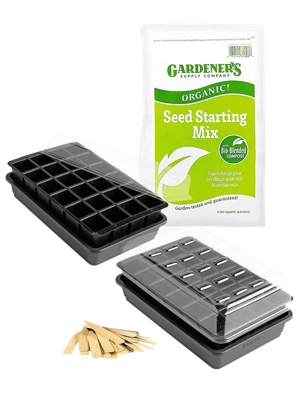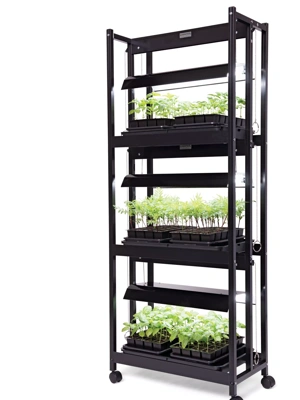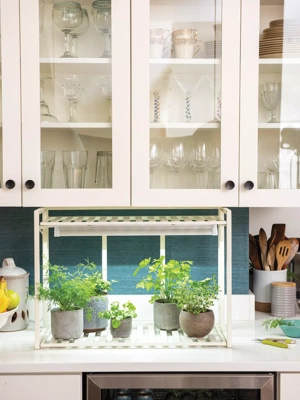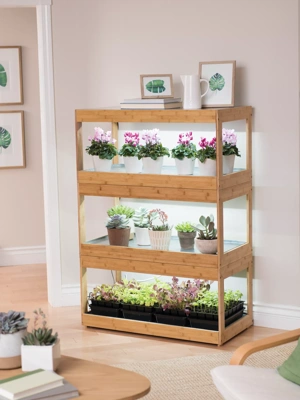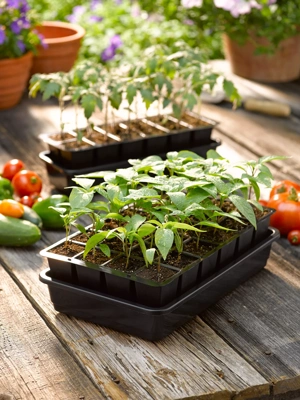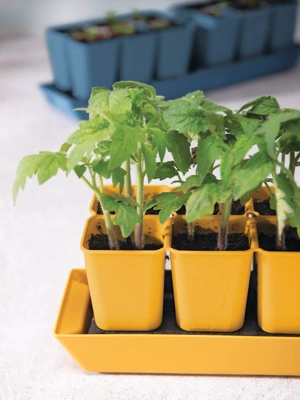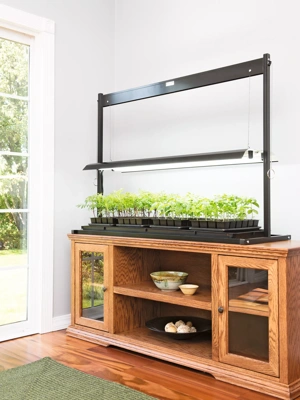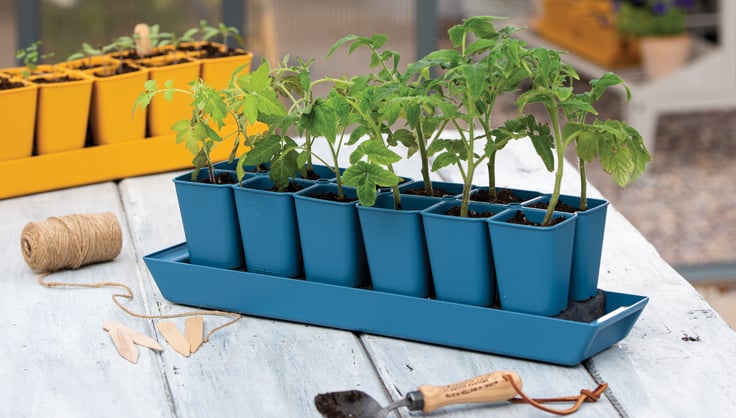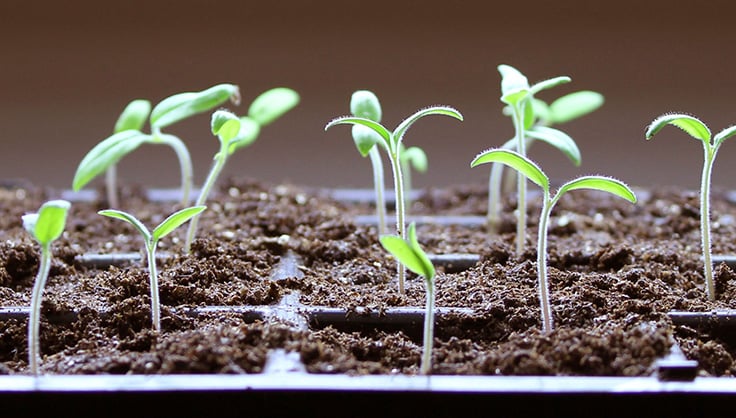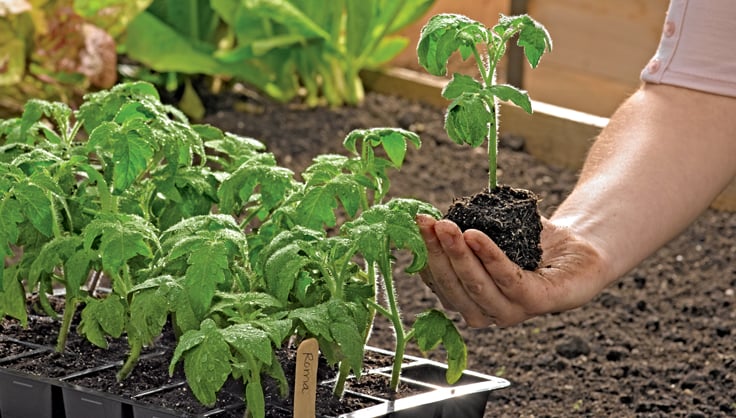How to Garden With Grow Lights
Set up your grow lights for houseplants, seedlings, and indoor edibles
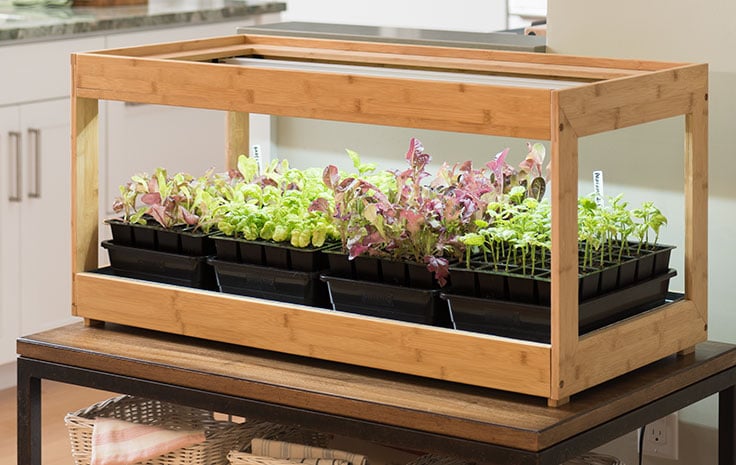
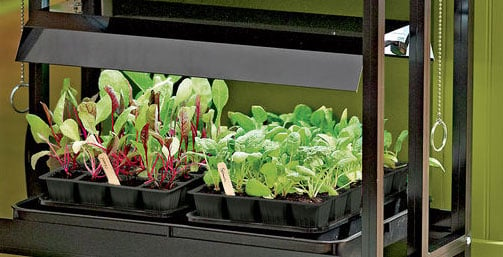 LED Grow Lights are perfect for indoor seed starting, as well growing as light-loving houseplants, such as orchids.
LED Grow Lights are perfect for indoor seed starting, as well growing as light-loving houseplants, such as orchids.Bring the sunlight indoors! With grow lights, gardeners can start a fleet of seedlings, get a rare orchid to bloom, and have fresh basil year-round regardless of their grow zone. Understanding the light needs of different plants will help you select an indoor grow lights system that is right for you.
What To Consider When Setting Up Grow Lights
1. The color temperature
As gardeners, why do we care about color temperature? Color temperature is a way to describe a light’s appearance. It’s measured in Kelvin (abbreviated as “K”) on a scale of 1,000 K (warmer red hues) to 10,000 K (cooler blues). Certain light color has been shown to trigger different plant growth characteristics. Blue light encourages vegetative growth; think strong stems, plenty of lush leaves, and dense roots. Red light promotes flowering and fruit. So, selecting red or blue bulbs give gardeners the option to select for different growth characteristics. Commercial growers looking to harvest a specialty crop on schedule may begin with a full spectrum bulb, then swap to red light bulbs to prompt flowering.
However, for all purpose growing of seedlings, houseplants, and herbs, “full spectrum” bulbs are the optimal choice. Full spectrum bulbs will generally be between 5000 and 6500 K, and will mimic bright, natural sunlight in appearance. Like plants growing outdoors in the sunlight, indoor plants generally grow best under full-spectrum bulbs, which produce a balance of cool and warm light that replicates the natural solar spectrum.
2. The distance between plants and the grow light
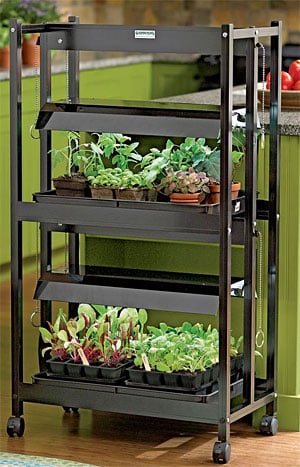 Our Vermont-made SunLite Gardens are available with either LED or fluorescent bulbs.
Our Vermont-made SunLite Gardens are available with either LED or fluorescent bulbs.The intensity of light that a plant receives is determined by both the brightness of the bulb and by how close the plant is to the light source. As soon as light photons leave a light bulb, they begin to dissapate outward — plants with high-light requirements (i.e. seedlings) must be tucked up close under the bulb. Typically, those plants that are native to tropical jungles or shady forests do not require as much light as plants that evolved in dry, sunny climates, such as the Mediterranean or southern Mexico.
3. How long to leave the grow light on
No matter what types of plants you are growing under them, your grow light should not be on 24 hours a day. The balance of light and dark affects many biological processes, including the growth rate, and the setting of buds and fruit. A power strip with built-in timer makes it easy to get the duration right.
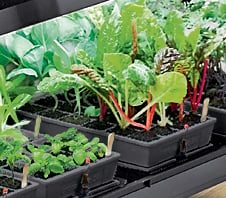 Seedlings need 14-16 hours of light a day.
Seedlings need 14-16 hours of light a day.Botanists usually divide plants into three categories relating to their preferred day length (photoperiod): short-day, long-day or day-neutral.
Short-day plants, such as chrysanthemums, kalanchoe, azaleas and begonias, will thrive on less than 12 hours of light per day. In fact, these plants must usually go through a series of even shorter days before they will set buds and flower.
Long-day plants require 14 to 18 hours of light each day. Most seedlings for vegetables and garden flowers are long-day plants. When they don't receive enough light they get pale and leggy.
Day-neutral plants, including foliage plants, geraniums, coleus and African violets, are usually satisfied with 8 to 12 hours of light all year-round.
How To Set Up Your Grow Light
What are you growing under lights? Ensure you have the right grow light for your plant needs.
For starting seeds
Color temperature: A full spectrum (5,000-6,500 K) bulb will imitate natural sunlight and produce strong, sturdy seedlings.
Distance from plant: Position your seedlings directly under the grow light. Weak, pale, “leggy” seedlings are often a sign that your plants are struggling to reach adequate light – move them closer! Bulbs can be 6 inches from the top of the seedlings, unless you have a high intensity LED bulb; these can be approximately 1 foot away from the plants. A grow light system with an easy-to-adjust bulb will allow you to raise the light as your seedlings grow.
Photoperiod: Seedlings require 14-16 hours of intense light per day.
For houseplants
Color temperature: Since we keep a vast array of plants as indoor houseplants, each species needs to be considered. A cool-colored, low intensity bulb can be used for snake plants, pothos, and other shade-tolerant foliage plants. Cacti, succulents, and flowering houseplants such as orchids and hibiscus, require a full spectrum bulb of high intensity.
Distance from plant: Houseplants don’t need particularly close contact with their grow light, especially if you are supplementing them with natural light from a nearby window. Grow lights can be 12-24 inches away from most houseplant foliage.
Photoperiod: Depending on the variety, your houseplant may need anywhere from 8 to 14 hours of light per day. Short-day plants, like poinsettia, kalanchoe, and Christmas cactus, need uninterrupted stretches of darkness and will only flower if they receive less than 12 hours of light per day.
For edible indoor gardens (herbs, veggies, and fruits)
Color temperature: As with houseplants and seedlings, a full spectrum light bulb will produce an abundance of healthy plants. Fruiting and flowering plants, like cherry tomato and citrus, may require a specialty bulb on the warmer end of the spectrum (2,500-3,000 K). If you are just growing leafy greens, a cooler bulb (6,000 K) will work well.
Distance from plant: For veggies and herbs, grow lights can be positioned 6-12 inches away from plants.
Photoperiod: Leafy greens like lettuce and spinach have moderate light needs; aim for 10-12 hours of light per day. Sun-loving herbs and fruiting plants have much higher energy requirements — for basil, tomato, and compact pepper varieties, try to replicate sunny outdoor growing conditions inside with a high-output LED light running for 14-18 hours per day.
Learn how to find a grow light that fits your situation. Presented by Laura from Garden Answer
Last updated: 01/18/2024
Print this Article:
Related items
Related Articles
Get the Dirt
Stay up to date on new articles and advice. Please fill out the information below.



